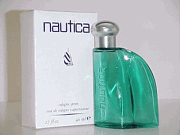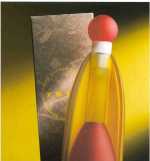 by Gabby by Gabby
Fragrance Basics
Part 2: Aaaaaah, the sweet smell of...?
Last month I covered some
basic perfume tips. This month I'll explain why some
perfumes might seem familiar and how to recognize
different perfumes with similar base scents.
 The sense of smell
is said to be the sense of imagination. Because of this
perfumes have strong emotional qualities and the gift of
recreating sweet memories or vivid images from the past.
A perfume is a highly personal adornment, it should be
adapted to your skin, your personality, your mood. Build
a fragrance wardrobe that defines you for different
occasions or at different times of the day. The sense of smell
is said to be the sense of imagination. Because of this
perfumes have strong emotional qualities and the gift of
recreating sweet memories or vivid images from the past.
A perfume is a highly personal adornment, it should be
adapted to your skin, your personality, your mood. Build
a fragrance wardrobe that defines you for different
occasions or at different times of the day.
Our perception of our environment is entirely dependent
on our senses and subconsciously affects our feelings.
Our sense of smell is more dynamic than our other senses.
Every day, we're in contact with at least thirty
different scents, shampoo, deodorant, detergent and air
fresheners are just a few examples.
Improve your sense of smell by learning to
recognize the different elements of each formulation;
close your eyes and visualize the blossoms and spices.
Learn to appreciate the depth and beauty of the fruity,
flowery and woody scents.
Essentials oils are natural, organic
substances generally derived from flowers, fruit trees or
roots. One scent alone doesn't make a perfume. Perfumers
develop a blend of essences through the simultaneous use
of several different oils. 
To describe these blends, perfumers refer to
the way in which their odor fades. The varying rate of
evaporation of essential oils are referred to as notes.
Notes such as eucalyptus and orange are light and
evaporate rapidly, where as patchouli and sandalwood are
slow and for this reason are often used to obtain a
lasting fragrance. The personality of the perfume is
created by the interplay between these different
essences.
These evaporation qualities are divided into three
categories: top notes are the scents that stand out the
most when you first smell a perfume. Middle notes
constitute the heart of the perfume which come to life
after the top notes fade away. Essences like rose and
jasmine are often used as a link between the fast and the
slow elements. Base notes make the scent endure as long
as possible, it contains lasting woody and resin
ingredients. After trying on a perfume, wait a moment .
This will allow the top note to diffuse and other facets
of the fragrance to develop.
There are a number of classical perfume
groups. There are many crossovers and no absolute rules.
The categories are constantly in a state of flux as new
scents are developed daily. The definitions and examples
below will help you understand the structure of perfume.
Floral
This is the largest category, making
up almost three-fourths of all feminine perfumes.
There are six subdivisions in this group.
Floral: single or
bouquets: rose, jasmine, ylang, neroli. Ex:
Poison, Chloe, Beautiful, Joy, Paris, White
Shoulders
Floral Aldehyde: synthetic
fragrances not found in nature; sparkling, sharp,
elegant and powerful. Ex: Chanel No. 5, Calandre,
First, Red, White Linen
Floral Fresh: freshness with
pineapple, mandarin, peach, plum, raspberry,
apricot and apple. Ex: Tribu, Calyx, Lauren, Liz
Claiborne, Escape, Amarige
Floral Fruity: delicate
spring-like freshness with subtle citrus notes.
Ex: Anais Anais, Moods, Destiny, Calyx
Floral Ambrey: heavy, warm and
sweet. Ex: Bijan's DNA, Tiffany, Oscar de la
Renta, L'Heure Blue
Floral Oriental: exotic florals
with spices, balsams and resins. Ex: Coco, Bijan,
Moschino, Escada, Vanderbilt, Chloe, Narcisse,
Diamonds
|
Chypre
French, for the island of Cypress, birthplace of
Venus. This category is woodsy and mossy with
sweet, warm, soft notes. There are six
subdivisions in this category.
Chypre:
marriage of citrus and oakmoss. Ex: Enigma,
Feminite, Du Bois
Chypre Fruity: mellow warmth
accented with peace. Ex: Mitsouko, Femme, Gem,
Cocktail, Colony
Chypre Floral Animalic: floral
and animal essence of civet, ambergis and musk.
Ex: Ysatis, Miss Dior, Givenchy III, Moments,
Jolie Madame
Chypre Floral: rich florals
supported by citrus, oakmoss, patchouli. Ex:
Paloma Picasso, Diva, Chant d' Aromes, Coriandre,
Aromatic Elixir, Cassini
Chypre Fresh: Highlights of
light citrus. Ex: Cristalle, 4711 Eau de Cologne,
Eau d'Hadrien, Eau de Rochas
Chypre Green: lightest of the
chypres with grassy and coniferous tones. Ex:
Wrappings, Private Collections, Aliage
|
Oriental
Oriental perfumes are best worn for evening and
cool weather. They are heavier fragrances with a
dominant animal, spicy or vanilla note, including
resins, woods, balsams and herbs. This category
has three subdivisions.
Oriental: heavy and
spicy. Ex: Angel, Realm, Nuit de Noel, Shalimar
Oriental Ambrey: blend of
citrus, amber and vanilla. Ex: Roma, Obsession,
Must de Cartier, Ciara, Dionne, Habanita,
Normandie
Oriental Spicy: very spicy with
nutmeg, cinnamon, pepper, clove, ginger and other
spices accented by spicy florals such as lavender
and carnation. Ex: Guerlain's Val de Nuit, Bal a
Versaille, Youth Dew, Opium
|
Citrus
One of the oldest fragrance concepts, becoming
very popular with women. Citrus is denoted by its
refreshing and exhilarating scent. Includes all
the fruit peels, plus petitgrain, neroli and
eucalyptus citriodora. Ex: Eau de Patou, Eau de
Guerlain, Eau de Cologne Imperiale, Eau de
Cologne Du Cog, Eau de Cologne Hermes
Fougere
Fresh fern with lavender, citrus, herbs and
oakmoss. Mainly a category for masculine scents.
Ex: Guerlain's Jicky
Green
This category has dominating notes of sage and
rosemary with grass, leaves and green floral such
as hyacinth. Ex: Pheromone, Reverie, Sung Spa
|
Last Words
A perfume should never be allowed to
dominate its surroundings. Less is always more
appropriate than more. The more businesslike the
occasion, the lighter, the more unobtrusive a
perfume should be. During the day, the lighter
fragrances such as the eau de toilette or eau de
cologne are appropriate. For the evenings, the
more concentrated perfumes are best. In the warm
seasons, fresh, sparkling flowery notes are
recommended. During the winter, the opposite is
generally suggested. Fortunately, no strict set
of rules exists. The way you put together a
fragrance wardrobe to match your different moods,
clothes, occasions and needs is wholly a matter
of your own, personal taste.
|
The only difference
between a cologne and a perfume is the
amount of concentration. Higher
concentration equals a stronger (and more
expensive) fragrance.
Perfume..............15-30%
Eau de Parfum......8-15%
Eau de Toilette......4 - 8%
Eau de Cologne.....3 - 5%
Splash Cologne.....1 - 3%
|
|
Fragrance is magical; it has the
unique ability to lift our spirits and enhance our mood.
Be aware of the fragrances you select, and why you choose
one over another. Learn to use fragrance for its maximum
benefit. Think of the positive effects fragrance can have
in your daily life, and in turn, the lives of those
around you.
HOT OFF THE PRESS
congratulates the winners of our May drawing
CHEERMOM
&
TWINSFAN
They each won one of the perfumes below for
correctly answering
Elizabeth Taylor to last month's contest question.
WTG to you both!
|

 by Gabby
by Gabby The sense of smell
is said to be the sense of imagination. Because of this
perfumes have strong emotional qualities and the gift of
recreating sweet memories or vivid images from the past.
A perfume is a highly personal adornment, it should be
adapted to your skin, your personality, your mood. Build
a fragrance wardrobe that defines you for different
occasions or at different times of the day.
The sense of smell
is said to be the sense of imagination. Because of this
perfumes have strong emotional qualities and the gift of
recreating sweet memories or vivid images from the past.
A perfume is a highly personal adornment, it should be
adapted to your skin, your personality, your mood. Build
a fragrance wardrobe that defines you for different
occasions or at different times of the day.



